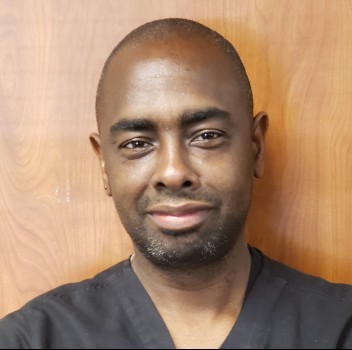A guest blog post by Kirk R. Cowardbéy, OTD, OTR/L, CLT, CSWS, FMT-C. This is a 9-minute read.
NOTE: This article contains graphic images of wounds.
Imagine having lymphedema and going from one therapist’s office to another in search of proper wound care. You hope to find someone with the talent and compassion to finally heal your wounds, but you keep hearing, “Sorry, we can’t help you here.”
These patients struggle physically, emotionally, and psychosocially. They may be misdiagnosed for a very long time, and even when they have a diagnosis they often find it a challenge to connect with a lymphatic therapist who can provide precisely the right type of care.
It would help the lymphedema community tremendously if more therapists were familiar with the condition, including becoming wound care certified or at least learning how to do the type of wrappings these patients need. Unfortunately, there seems to be a lack of basic knowledge about caring for lymphedema patients’ wounds.
It’s understandable that therapists don’t want to do something out of their scope and prefer to have the right kind of training first. Plus, lymphedema wounds can be smelly, unpleasant, and quite demanding to address. This may diminish therapists’ enthusiasm to advance their knowledge about wound care.
I’ll admit, I didn’t start out focusing on lymphedema but it grew close to my heart when I worked at a terrific hyperbaric wound care center in Houston, Texas. The physicians there took me under their wing and taught me how to treat wounds effectively. I quickly became very good at wound care and discovered I had a passion for helping people with lymphedema.
Understanding Ulcers and Lymphatic Damage
A person with lymphedema may have an immune system that in affected regions may not function normally. They may be more likely to have cellulitis. They often have tissue damage and skin changes that are uncomfortable and embarrassing for them.
Lymphedema causes a series of skin changes over time. The skin thins, decreases in integrity, increases in permeability, and ultimately develops ulcers. At the same time, the person’s skin is becoming less able to heal as new tissue growth is hindered.
Leg ulcers are very common with lymphedema and develop due to weak and impaired valves, causing venous reflux. This may involve venous stasis, which is a type of chronic venous insufficiency that causes blood to pool or clot within the veins.
Over time, lymphatic wounds build up such severe congestion that healing is almost completely compromised. Regardless of the etiology of their wounds, patients may face permanent skin changes. However, if there had been early intervention before this point of no return, the patient may have experienced a better outcome.
Healing Lymphatic Wounds With Compression Therapy
Compression therapy is one of the best treatments available for those with lymphedema. It decreases the amount of edema within the wound area and recruits oxygen-rich blood to work its healing magic.
When a therapist initiates compression treatment, the patient’s tissue becomes receptive to the increased flow of oxygen. Although it takes time to see results from compression treatments, the overall healing time for lymphatic wounds can be decreased by months through the use of compression therapy.
Clinical Experiences With Wound Healing
I’d like to share some examples of patients who have achieved positive outcomes through CLT intervention.
Age 84, a Patient with Severe Primary Lymphedema
 This 84-year-old patient had a wound that was 3 centimeters by 12 centimeters by .3 centimeters on the right lower extremity & 32.5 centimeters by 11 centimeters. The wounds were at full thickness and this patient had already been receiving wound care for approximately 11 years.
This 84-year-old patient had a wound that was 3 centimeters by 12 centimeters by .3 centimeters on the right lower extremity & 32.5 centimeters by 11 centimeters. The wounds were at full thickness and this patient had already been receiving wound care for approximately 11 years.
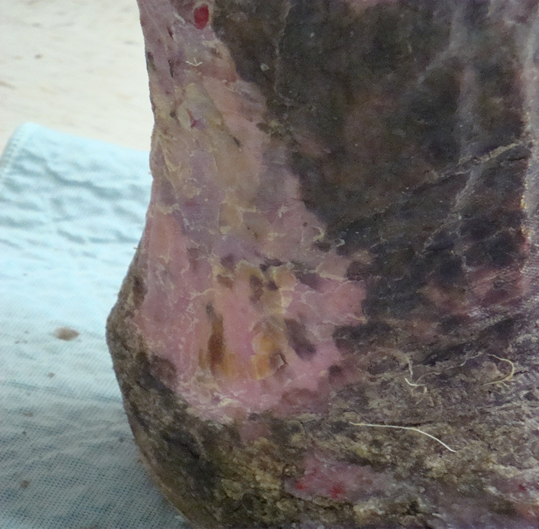 For this patient, we used a combination of integrated medication, debridement, and compression therapy. After just 8 months the patient presented with superficial wounds measuring approximately 1 centimeter by 1 centimeter by .1 centimeter. The patient was discharged to another hospital for an unrelated injury. The patient’s conditioned was transitioned into the maintenance therapy with the FarrowWrapⓇ Classic.
For this patient, we used a combination of integrated medication, debridement, and compression therapy. After just 8 months the patient presented with superficial wounds measuring approximately 1 centimeter by 1 centimeter by .1 centimeter. The patient was discharged to another hospital for an unrelated injury. The patient’s conditioned was transitioned into the maintenance therapy with the FarrowWrapⓇ Classic.
Age 85, a Smoker With Secondary Lymphedema
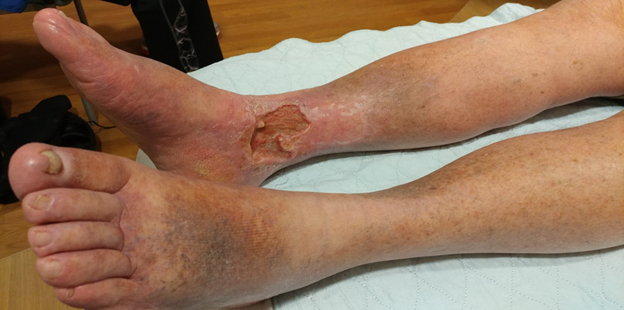 This 85-year-old patient was a long-term smoker who had experienced swelling for more than 20 years and had a chronic venous stasis ulcer.
This 85-year-old patient was a long-term smoker who had experienced swelling for more than 20 years and had a chronic venous stasis ulcer.
There was a 7 centimeter by 5 centimeter by 3 centimeter wound in the left malleolar area with a strong odor and heavy drainage.
We did CLT intervention for 14 months, which required compression, MLD, rote exercise, topical medication, and NPWT (Negative Pressure Wound Therapy).
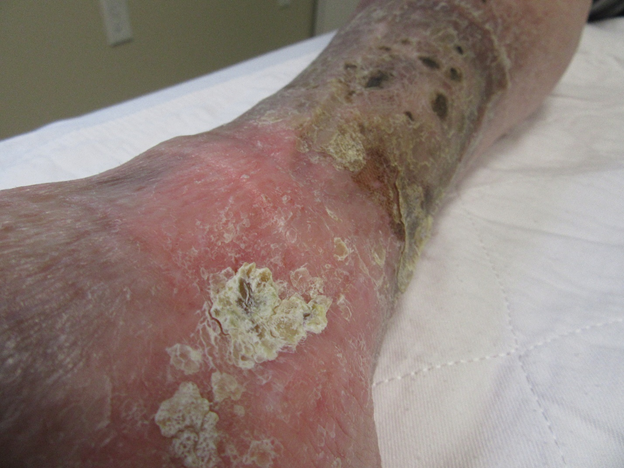 We discharged this patient with instructions to use a compression stocking, the FarrowWrapⓇ Classic, and a vasopneumatic device.
We discharged this patient with instructions to use a compression stocking, the FarrowWrapⓇ Classic, and a vasopneumatic device.
Age 80, a Patient With Severe Open Wounds
When this patient arrived for his appointment, he came with a group of people including his daughter, his caregiver, and several others. I removed his wrappings to find so much more damage than I expected. He had large, open, and weeping wounds with fat and tendons showing throughout his legs and toes. The smell was rancid.
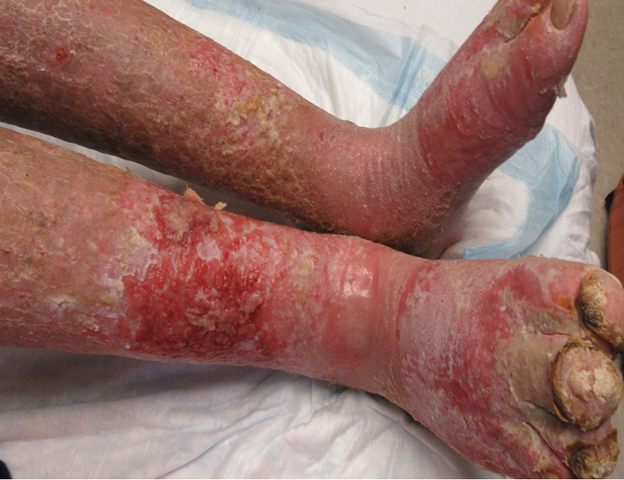 I learned he’d been dealing with these wounds for at least three years, and possibly up to five or six years. He had previously visited a podiatrist who debrided his wounds repeatedly but gave him very little relief.
I learned he’d been dealing with these wounds for at least three years, and possibly up to five or six years. He had previously visited a podiatrist who debrided his wounds repeatedly but gave him very little relief.
His one-hour evaluation became a two-hour-plus evaluation and treatment process. I carefully cleaned out his wounds using saline and a chlorine solution, gave him breaks, and further debrided his wounds. I applied Iodosorb, which is a sterile antimicrobial dressing with almost a peanut-butter-like texture we use for these types of wounds.
We began a treatment regimen where he visited three to four times per week. Eventually, his wounds showed significant improvement.
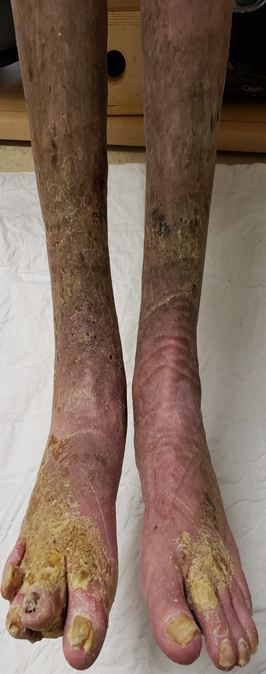
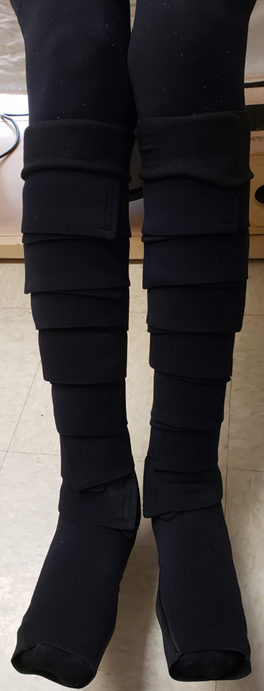 Even for a severe case like this, after approximately one year of treatment, he was able to be discharged with aftercare instructions.
Even for a severe case like this, after approximately one year of treatment, he was able to be discharged with aftercare instructions.
CLT Recommendations for Patient Care
Although it takes an experienced therapist to handle a case like the one I just described, any CLT should be able to administer basic wound care and compression bandages for most lymphedema patients. In addition, CLTs should provide patients with three treatment options:
- Simple dressing changes
- A contact layer that has direct contact with the wound
- A secondary absorbent layer without direct wound contact
As therapists, it’s important for us to provide a multidisciplinary approach that involves a wound care nurse and/or wound care department. We should provide same-day dressing and bandaging management to minimize the time that the limb is without gradient compression therapy.
Keep in mind that additional time without compression therapy may lead to:
- Increased congestion
- Critical colonization of the wound
- Further damage to healthy lymphatics
- Cellulitis infection
If you are unable to provide wound care yourself, refer the patient to a qualified CLT who specializes in wound care and can do any of the following, if necessary:
Provide simple to complex dressing changes
- Suggest diet enhancements
- Perform nonsurgical debridement
- Follow standard compression protocols
- Utilize alternative compression practices when necessary
- Offer multi-layer gradient compression therapy as needed
In closing, I’d like to encourage all occupational therapists to learn as much as possible about lymphedema wound treatment. In addition, I urge therapists to take a compassionate approach to these patients who are facing the daily challenges of lymphedema. In time, I trust more therapists will continue to gain wound care certification and provide the basic wound care services these patients so desperately need.
About Kirk R. Cowardbéy
Kirk R. Cowardbéy, OTD, OTR/L, CLT, CSWS, FMT-C is a Doctor of Occupational Therapy (OTD) as well as an adjunct professor at Coleman College. He works with the TIRR-M.H. West University Center of Excellence in Lymphedema Management, Limb Loss, and Oncology Rehabilitation in Houston, Texas, and previously worked at the Memorial Hermann Hospital Wound Care, Hyperbaric, and Lymphedema Clinic. He is a member of ABWH, the American Board for Wound Healing
